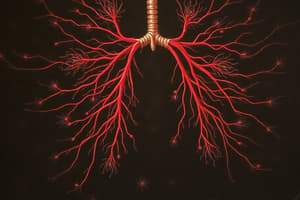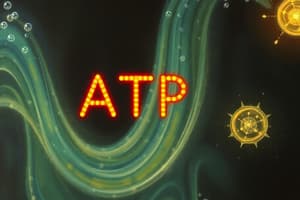Podcast
Questions and Answers
Which energy system provides energy for activities lasting less than 10 seconds?
Which energy system provides energy for activities lasting less than 10 seconds?
- Anaerobic system
- Aerobic system
- ATP-CP system (correct)
- Oxidative system
Which macronutrient primarily fuels high-intensity aerobic activities?
Which macronutrient primarily fuels high-intensity aerobic activities?
- Vitamins
- Carbohydrates (correct)
- Fats
- Proteins
In terms of energy, which is true about fats compared to carbohydrates and proteins?
In terms of energy, which is true about fats compared to carbohydrates and proteins?
- Fats provide more energy than carbohydrates but not proteins. (correct)
- Fats provide the same amount of energy as carbohydrates.
- Fats provide less energy than carbohydrates.
- Fats provide no energy compared to carbohydrates.
What is the role of proteins in energy metabolism during exercise?
What is the role of proteins in energy metabolism during exercise?
Which of the following activities primarily relies on the anaerobic energy system?
Which of the following activities primarily relies on the anaerobic energy system?
Which energy system is predominant during activities lasting between 200 to 400 meters?
Which energy system is predominant during activities lasting between 200 to 400 meters?
How does the length and intensity of exercise affect energy system utilization?
How does the length and intensity of exercise affect energy system utilization?
Which type of exercise primarily utilizes the aerobic energy system?
Which type of exercise primarily utilizes the aerobic energy system?
Which system primarily provides energy for high intensity exercises lasting up to 10 seconds?
Which system primarily provides energy for high intensity exercises lasting up to 10 seconds?
What is the role of mitochondria in energy production?
What is the role of mitochondria in energy production?
What color are slow-twitch muscle fibers primarily associated with?
What color are slow-twitch muscle fibers primarily associated with?
Which energy system would be predominantly active during a 5000m race?
Which energy system would be predominantly active during a 5000m race?
Which statement best describes the ATP-PCr system?
Which statement best describes the ATP-PCr system?
In terms of cardiorespiratory response to exercise, which factor is most influenced by aerobic training?
In terms of cardiorespiratory response to exercise, which factor is most influenced by aerobic training?
Which of the following processes occurs during anaerobic metabolism?
Which of the following processes occurs during anaerobic metabolism?
What main component does myoglobin facilitate in muscle tissues?
What main component does myoglobin facilitate in muscle tissues?
What is the primary energy system utilized by fast twitch fibers during high-intensity activities?
What is the primary energy system utilized by fast twitch fibers during high-intensity activities?
Which of the following statements accurately describes the energy production capabilities of fast twitch fibers?
Which of the following statements accurately describes the energy production capabilities of fast twitch fibers?
In the context of muscular performance, what determines the amount of force a muscle can generate?
In the context of muscular performance, what determines the amount of force a muscle can generate?
Which of the following athlete categories is likely to have a higher percentage of slow twitch fibers?
Which of the following athlete categories is likely to have a higher percentage of slow twitch fibers?
What is the main role of the ATP-CP system in energy production?
What is the main role of the ATP-CP system in energy production?
What primary fuels are utilized in cellular respiration for ATP production?
What primary fuels are utilized in cellular respiration for ATP production?
Why do sprinters generally have a higher proportion of fast twitch fibers?
Why do sprinters generally have a higher proportion of fast twitch fibers?
Which factor does NOT influence muscle contraction strength?
Which factor does NOT influence muscle contraction strength?
Flashcards are hidden until you start studying
Study Notes
ATP and Energy Systems
- ATP (Adenosine Triphosphate) is a vital organic compound providing energy for various cellular processes, including nerve impulse transmission and muscle contraction.
- ATP-PCr system, also known as the immediate energy system or phosphagen system, supports high-intensity activities lasting up to 10 seconds, such as weightlifting and sprinting.
Myoglobin and Mitochondria
- Myoglobin is a red pigment in muscles, similar to hemoglobin, essential for oxygen storage and transport.
- Mitochondria are cellular organelles responsible for energy production through cellular respiration, rich in fats, proteins, and enzymes.
Metabolism Types
- Metabolism encompasses all energy transformations in the body.
- Anabolism involves synthesizing complex molecules from simple ones.
- Catabolism refers to breaking down food to release energy.
Energy Sources During Exercise
- Carbohydrates provide quick energy for short-duration activities while fats yield more energy for longer exercises.
- ATP-CP system fuels activities under 10 seconds; anaerobic system supports efforts lasting up to 2 minutes, like 200m or 400m races.
- Aerobic system powers long-duration activities, such as marathons or team sports.
Muscle Fiber Types
- Fast-twitch (Type II) fibers facilitate anaerobic activity and exhibit a rapid contraction rate but fatigue quickly; they have fewer mitochondria.
- Slow-twitch (Type I) fibers support prolonged, aerobic activities, showcasing high endurance and fatigue resistance.
- Different athletes possess varying muscle fiber compositions—sprinters typically have more fast-twitch fibers, while endurance runners have more slow-twitch fibers.
Force Generation Factors
- The force of muscle contraction is influenced by motor unit type and number, muscle length, neural stimulation, and previous contractions.
Athlete Fiber Composition
- Long-distance runners: 70-80% slow twitch, 20-30% fast twitch.
- Sprinters: 25-30% slow twitch, 70-75% fast twitch.
- Non-athletes: 48-52% slow twitch, 48-52% fast twitch.
Cellular Respiration
- Cellular respiration is the process used to form ATP from nutrients, primarily carbohydrates, proteins, and fats, each undergoing unique chemical conversions for energy production.
Studying That Suits You
Use AI to generate personalized quizzes and flashcards to suit your learning preferences.




